Nyheter
Bybit’s $1.5B Hack: The Largest in Internet History
Publicerad
1 månad sedanden

On February 21, 2025, Bybit, a leading global centralized cryptoasset exchange (CEX) specializing in spot and derivatives trading, experienced a historic breach resulting in the theft of approximately $1.5B. This incident now stands as the largest recorded hack in both crypto and broader internet history, surpassing prior breaches in scale and complexity. The attack targeted Bybit’s Ethereum-based cold wallet infrastructure, exploiting vulnerabilities in multi-signature protocols and transaction verification processes. Immediate remediation efforts by the exchange and industry partners have since stabilized operations, though the event underscores systemic risks in cryptoasset custody.
Inside Bybit’s $1.5B Hack: What We Know So Far
The exploit occurred when a hacker manipulated a wallet signature, tricking Bybit’s system into approving a transaction that altered the smart contract logic of its ETH cold wallet. The attack was disguised or “musked” to appear legitimate, showing the correct address and a trusted URL to Bybit’s team. However, this action inadvertently granted full custodial privileges, enabling the transfer of 401.35K ETH, valued at around $1.4B, and associated liquid staking derivatives (e.g., stETH, cmETH, mETH) to the hacker’s wallet.
The Impact on the Broader Market and ETH
The hack sparked a sell-off driven by investor fears of broader market fallout on the day of the breach. ETH tumbled 8%, sliding from approximately $2.85K to $2.61K, while BTC dropped from just shy of $100K to $95K, and SOL briefly fell below $160. Despite the sharp reaction, the downturn proved short-lived, with all three assets rebounding to close the day within 5% of their opening levels. Although prices initially rebounded, the market faced renewed pressure this week due to the unwinding of several leveraged positions, heightened macroeconomic uncertainty following President Trump’s comments on imposing tariffs, and worsening market sentiment. To provide deeper insights, we will release a detailed report later this week analyzing the key drivers behind the current movements.
Figure 1: BTC, ETH, SOL Price Performance Throughout February 21
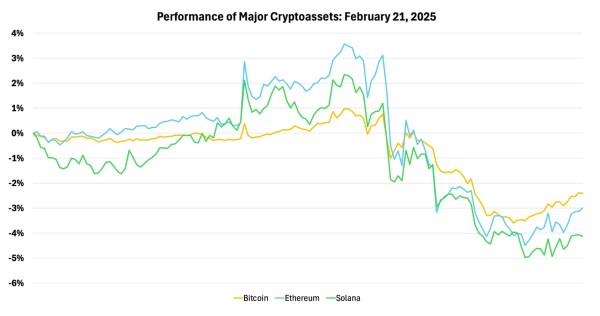
Source: 21Shares, Glassnode
Nevertheless, Bybit quickly assured users that all other cold wallets remained secure and that withdrawals were functioning as normal. However, as seen below, this didn’t stop many users from withdrawing their funds from the exchange, adding to a total amount of around $6B in withdrawals.
Figure 2: Bybit Assets under Management vs. Net Flows in February
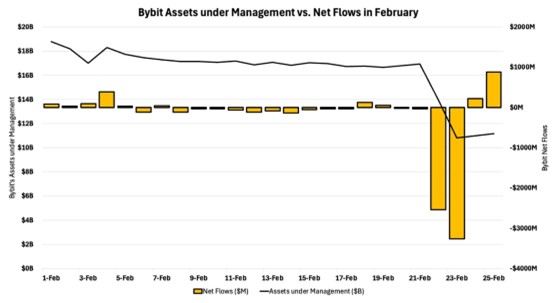
Source: 21Shares, DeFiLlama
Concurrently, over $566M in crypto long and short positions were liquidated across exchanges on February 21 as investors sought to mitigate risk amidst heightened uncertainty.
Figure 3: Crypto Futures Market Liquidations: Longs & Shorts
Source: 21Shares, Coinglass
Following the initial market volatility, ETH experienced a temporary 3.36% rebound to $2.76K, driven by speculation that Bybit would initiate a large-scale ETH repurchase to address liquidity concerns. As it turned out, they engaged in repurchasing some ETH, while other industry participants supported their efforts by lending them some capital, as we’ll break down later in the report. That said, this upward movement coincided with aggressive accumulation by high-net-worth individuals following the exchange’s public disclosure of the breach, as seen below.
Figure 4: ETH Performance vs. Accumulation by Large Holders

Source: 21Shares Glassnode
Beyond the majors, Ethena’s USDe stablecoin was initially projected to be exposed to the Bybit breach due to $30M in derivative hedging exposure on the exchange, which posed a potential risk to its collateralization framework. However, Ethena’s reserves ($65M as of 24th of February 2025) exceeded this exposure, and its assets—held in off-exchange custody solutions such as Copper’s Clearloop —were insulated from direct losses. Through rapid mitigation, Ethena reduced its exposure to $10M within hours and fully eliminated it by February 22, ensuring USDe remained fully collateralized despite the breach. In fact, Ethena was able to honor the largest un-staking request in its history, worth $250M, without any delays or by causing a severe depeg for the stablecoin, as seen below:
Figure 5: Ethena’s USDe Price vs. Staking and Unstaking Net Flows
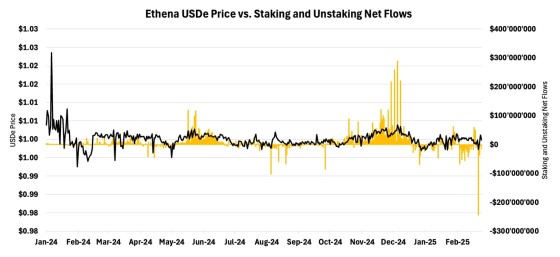
Source: Dune
All in all, despite the scale of the attack, Figure 6 shows that the stolen funds represent 7.50% of Bybit’s $20B in assets under management. With deep liquidity and diversified holdings across Bitcoin, stablecoins, and other assets, Bybit remains fully solvent and has already addressed the breach, ensuring continued operations without disruption to user funds.
Figure 6: Pre-Hack Breakdown of Bybit’s Assets under Management
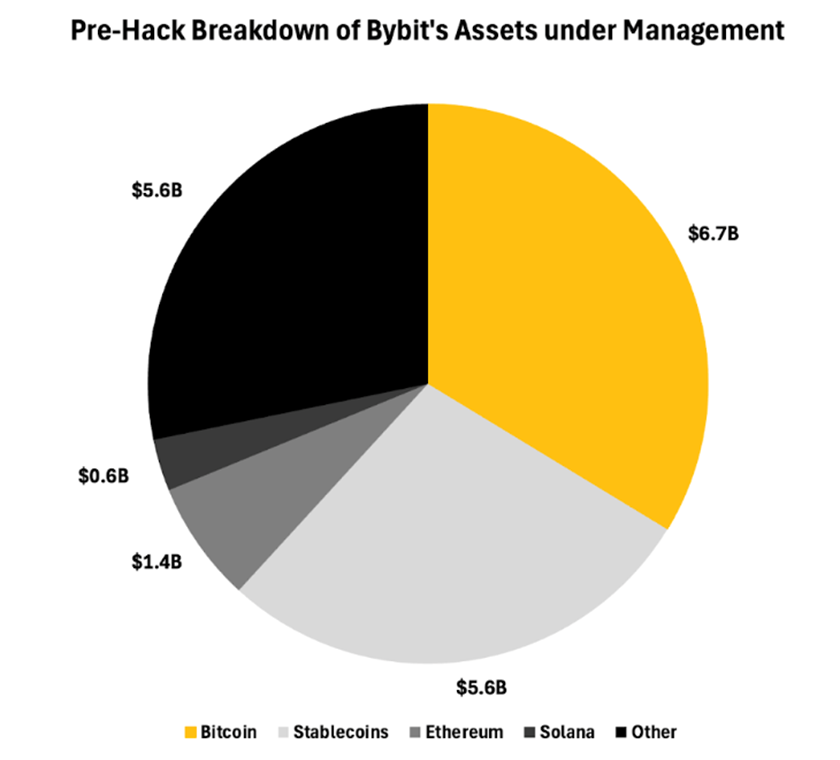
Source: 21Shares, Arkham Intelligence
In addition, thanks to the transparency of blockchain technology, where every transaction can be traced, blockchain security experts quickly identified The Lazarus Group, a North Korean state-backed hacking organization, as the perpetrators behind the Bybit exploit. The group has a long history of executing some of the largest cyber heists in the digital asset space, allegedly using stolen funds to support North Korea’s weapons programs. Lazarus has been linked to several high-profile crypto breaches, including the $625M Ronin Bridge hack (2022). Their operations extend beyond crypto, with their fingerprints on major cyberattacks like the 2014 Sony Pictures hack and the 2016 Bangladesh Bank heist, where they attempted to steal nearly $1B via the SWIFT banking system.
Figure 7: Lazarus Group: Hacking Activity Over the Years

Source: 21Shares, Chainalysis
Where Do We Stand Today?
Bybit has already tracked and recovered approximately $50M in stolen crypto, monitoring real-time fund movements. The exchange is working closely with centralized platforms and stablecoin providers to identify, block, and freeze wallets associated with the hackers, significantly restricting their ability to launder the stolen assets. This rapid response highlights how blockchain’s inherent transparency can be a powerful tool in combating cybercrime.
Further, as of February 24, Bybit has fully replenished its Ethereum reserves with 446.87K ETH worth around $1.23B, independently verified by analytics firm Lookonchain. The reserve restoration was achieved through a combination of CEX purchases, strategic loans from institutional partners, and over-the-counter (OTC) transactions with high-net-worth entities, as illustrated below:
Figure 8: Detailed Breakdown of the Entities that Supported Bybit
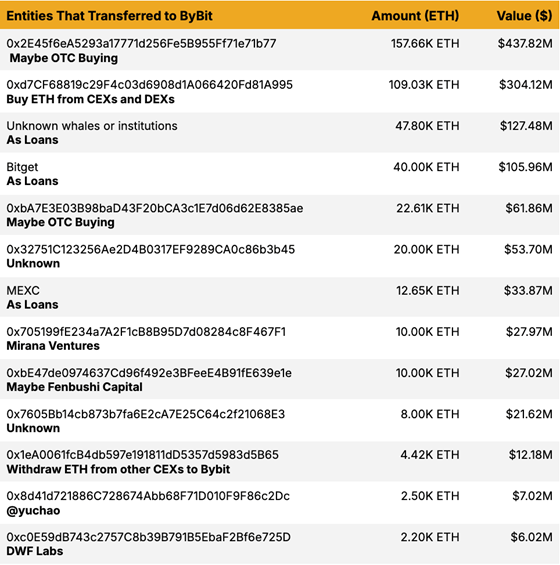
Source: LookOnChain
From this perspective, the crypto industry showcased a rapid and unified effort to support Bybit, recognizing its critical role as the fifth-largest exchange in the derivatives market and seeking to avert a crisis akin to the FTX collapse. This assistance extended beyond entities providing capital—whether through unconditional loans or other means—to include a diverse range of service providers working collectively to mitigate the risk of contagion. These included:
Security and Forensic Assistance
- ZachXBT & Arkham Intelligence: Identified Lazarus Group’s involvement through on-chain analysis of fund laundering patterns
- Elliptic: Traced stolen funds to North Korean operatives and alerted exchanges to freeze $42.89M in assets.
- Fireblocks: Conducted forensic analysis of the attack vector (proxy contract exploit).
- Hacken: Audited Bybit’s proof-of-reserves post-recovery.
- Chainflip: Monitored Lazarus’ ETH-to-BTC bridge attempts despite decentralized limitations.
Asset Freezes and Anti-Laundering Efforts
- Tether: Froze $181K in stolen USDT linked to hacker addresses.
- Mantle Network: Frozen hacker-controlled mETH derivatives to prevent further laundering.
Taking a Step Back…
As seen in Figure 9, Crypto exchange hacks are not new, and history has shown that the scale of these breaches can have lasting impacts. In 2014, Mt. Gox, which at the time handled over 70% of global Bitcoin transactions, suffered one of the most infamous hacks, losing 850K BTC. While worth approximately $450M then, at today’s price of $96K per Bitcoin, that loss would be valued at over $81B. Similarly, Bitfinex experienced a major breach in 2016, losing 119.76K BTC – an amount that was valued at $72M at the time, which would be worth over $11.5B today. These incidents highlight the significant risks of holding assets on centralized exchanges, as security vulnerabilities, insider threats, and external attacks have repeatedly led to catastrophic losses for users. Despite advancements in security practices, these risks persist, making it increasingly clear why institutional investors are turning to regulated investment vehicles like ETPs to gain exposure to digital assets.
Figure 9: Largest Crypto Hacks
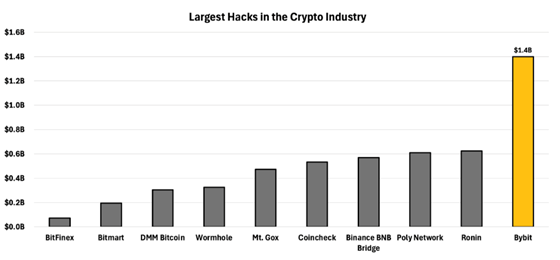
Source: 21Shares, Investopedia
Exchange-Traded Products (ETPs): The Secure, Regulated Path to Crypto Exposure
There remain multiple ways to get crypto exposure today, each with its trade-offs, as outlined in Figure 10. Nevertheless, the Bybit hack is another reminder of a fundamental challenge: how to store assets securely without sacrificing accessibility.
Figure 10: Ways to Invest in Cryptoassets
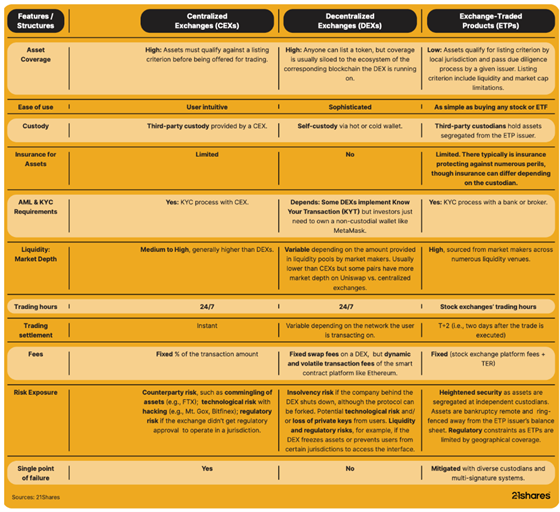
Source: 21Shares
While CEXs may provide instant settlement and greater asset coverage, they expose users to counterparty risk—where a single failure can lead to catastrophic losses. Self-custody, while offering users full control, demands technical expertise to mitigate risks like hacks, mismanagement of keys, and smart contract vulnerabilities. Against this backdrop, ETPs emerge as a solution when it comes to mitigating risk.
Figure 11: How Cryptoassets are Custodied

Source: 21Shares
In the wake of the Bybit hack, and until institutional and mainstream investors are ready to transition to self-custody—a shift that will likely take time—ETPs offer a practical alternative. As seen in Figure 10, ETPs offer a range of benefits, making them an increasingly attractive option for transparent and regulated crypto exposure.
• Regulated Oversight: ETPs are regulated financial instruments that are overseen by financial authorities. This ensures full transparency in asset holdings, security measures, and operational practices, removing risk of fund mismanagement as seen with FTX.
• Institutional-Grade Custody: Assets are held with specialized custodians, largely inaccessible to individual investors, focused solely on digital asset security.
• Multi-Custodian Model: Assets are distributed across multiple custodians, reducing the risk of any single point of failure.
• Ringfenced Assets: Assets are ring-fenced from the issuer, ensuring full protection—even in the event of insolvency.
What To Expect Moving Forward?
The potential liquidation of the stolen ETH by the Lazarus Group could exert significant forced selling pressure on the assets in the short to medium term, especially if large sell-offs occur during periods of low market liquidity. This incident may also accelerate the ongoing migration toward non-custodial infrastructure, mirroring the trend that followed the collapse of FTX, as users increasingly prioritize self-custody overreliance on CEXs, as depicted in Figure 11. Regulatory scrutiny is expected to intensify, particularly targeting mixer services like eXch, which have been exploited for laundering funds. As regulations take shape, centralized exchanges may be required to implement insurance funds similar to protections offered by traditional stock exchanges.
Figure 12: Decentralized to Centralized Exchange Spot Volumes
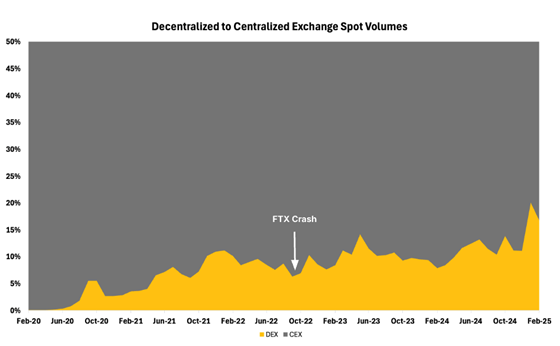
Source: 21Shares, TheBlock
Much like Mt. Gox collapse in 2014 spurred advancements in exchange security; this hack could serve as a catalyst to strengthen crypto’s infrastructure through standardized custody audits and real-time treasury management systems. The breach also exposed vulnerabilities in multi-signature wallet security, previously considered robust, prompting an industry-wide reassessment of custody solutions and potentially accelerating the adoption of more advanced technologies like multi-party computation (MPC). Smaller exchanges may also struggle to retain user trust in this heightened security environment, likely leading to further consolidation within the industry as users gravitate toward larger platforms with proven safeguards.
The market’s reaction earlier this week suggests a heightened awareness of the persistent risks associated with crypto exposure following the recent hack, prompting some participants to potentially de-risk their positions. As noted, we will provide a more detailed report analyzing the market’s recent behavior in the coming days.
What’s happening this week?
• Thursday, February 27: The main event of ETHDenver starts – it’s a longstanding community-led annual conference that brings Ethereum developers together. Announcements often excite investors.
• Friday, February 28: The monthly reading of the Core PCE Price Index, the Fed’s favorite gauge of inflation. As a macro asset, some Bitcoin investors are usually influenced by inflation data in their investment decisions.
Research Newsletter
Each week the 21Shares Research team will publish our data-driven insights into the crypto asset world through this newsletter. Please direct any comments, questions, and words of feedback to research@21shares.com
Disclaimer
The information provided does not constitute a prospectus or other offering material and does not contain or constitute an offer to sell or a solicitation of any offer to buy securities in any jurisdiction. Some of the information published herein may contain forward-looking statements. Readers are cautioned that any such forward-looking statements are not guarantees of future performance and involve risks and uncertainties and that actual results may differ materially from those in the forward-looking statements as a result of various factors. The information contained herein may not be considered as economic, legal, tax or other advice and users are cautioned to base investment decisions or other decisions solely on the content hereof.
Du kanske gillar
-
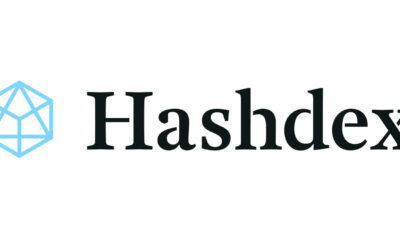

Spotlight on the tariff war
-
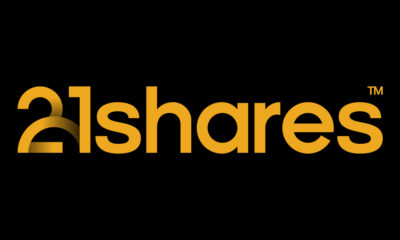

Michael Saylor’s bold Bitcoin bet and Strategy’s risk analysis
-


US regulatory shift provides a beacon for optimism
-
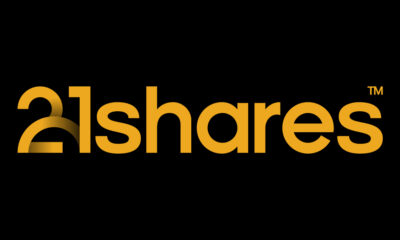

21Shares ringer i klockan på Nasdaq Stockholm
-
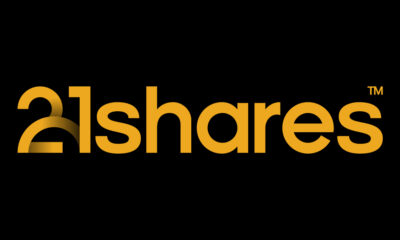

Crypto Market Risks & Opportunities: Insights on Bybit Hack, Bitcoin, and Institutional Adoption
-


WisdomTree sänker avgiften för fysisk Bitcoin ETP till 0,15 %

UBS ETF (IE) S&P 500 Equal Weight SF UCITS ETF (USD) A-dis (S5EW ETF) med ISIN IE000OAZZ3X6, försöker följa S&P 500® Equal Weight-index. S&P 500® Equal Weight (EWI)-index följer stora amerikanska aktier med lika vikt och fast vikt på 0,20 %.
Den börshandlade fondens TER (total cost ratio) uppgår till 0,12 % p.a. UBS ETF (IE) S&P 500 Equal Weight SF UCITS ETF (USD) A-dis är den billigaste ETF som följer S&P 500® Equal Weight-index. ETFen replikerar resultatet för det underliggande indexet syntetiskt med en swap. Utdelningarna i ETFen delas ut till investerarna (halvårsvis).
ETFen lanserades den 20 februari 2025 och har sin hemvist i Irland.
Översikt
Investeringsmålet är att replikera resultatet för S&P 500 Equal Weight Index.
Fonden replikerar syntetiskt indexutvecklingen genom att investera i en swap.
Swapmotparten överför säkerheter till ETFen i form av G10-statsobligationer, överstatliga obligationer och kontanter.
Fördelar
Kunder drar nytta av flexibiliteten hos en börshandlad investering och investerarskyddet som en fond erbjuder.
Ger tillgång till detta segment av marknaden med en enda transaktion.
Optimerad risk/avkastningsprofil tack vare en bred diversifiering över en rad sektorer.
Fonden erbjuder en hög grad av transparens och kostnadseffektivitet och är lätt att handla.
UCITS-kompatibel fond.
Handla S5EW ETF
UBS ETF (IE) S&P 500 Equal Weight SF UCITS ETF (USD) A-dis (S5EW ETF) är en europeisk börshandlad produkt som handlas på London Stock Exchange.
London Stock Exchange är marknader som få svenska banker och nätmäklare erbjuder access till, men DEGIRO gör det.
Börsnoteringar
| Börs | Valuta | Kortnamn |
| London Stock Exchange | GBX | S5EW |
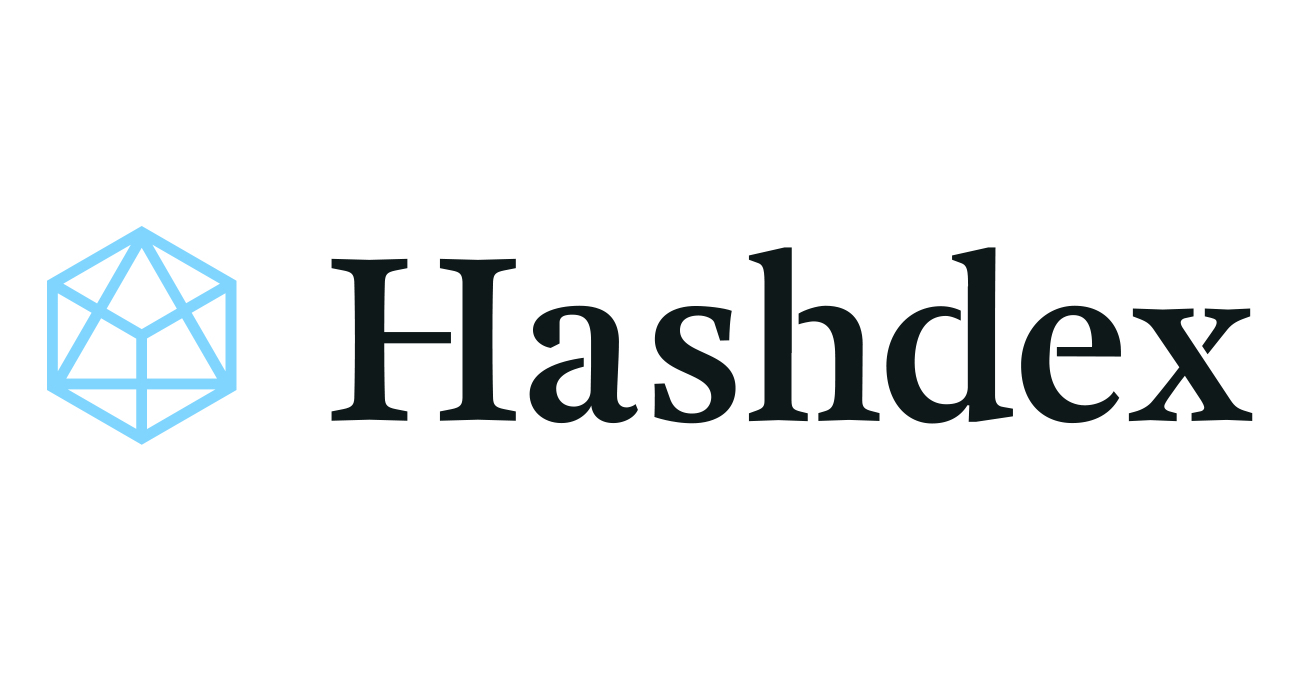
The impact of US tariffs continues to dominate market sentiment and risk assets, including crypto, struggled with this uncertainty throughout the month. The Nasdaq Crypto Index™ (NCI™) fell 4.46% in March as the S&P 500 and Nasdaq 100 dropped 5.63% and 7.61%, respectively.
Despite the macro uncertainty from Washington, US policymakers are continuing to embrace crypto in an unprecedented way, including launching a Bitcoin Strategic Reserve, Digital Asset Stockpile, and engaging in expansive work at the regulatory agencies and in Congress.
Our team spent the last week of the month in Washington, meeting with regulators to share our experiences and views on what’s most important for crypto investors in the US. In his latest Notes from the CIO, Samir Kerbage shares what he learned from these meetings and how investors should be thinking about the new regulatory regime in the US.
As always, we are greatly appreciative of your trust in us and are here to answer any questions you may have.
-Your Partners at Hashdex
Market Review
March was marked by the tariff dispute triggered by the Trump administration. Back-and-forth fiscal policies, threats, and retaliations dominated the month’s agenda. The uncertain macroeconomic environment put investors into a defensive stance and negatively impacted crypto assets. The Nasdaq Crypto Index™ (NCI™) closed the month down -4.46% after a period of high volatility. Major market indices, the S&P 500 and Nasdaq-100, also recorded steep declines of -5.63% and -7.61%, respectively. These concurrent drawdowns across equities and crypto underscored March’s broad market caution, as trade war uncertainty prompted investors to flee risk assets.
During times of uncertainty, it is common to observe increased correlation among different classes of risk assets. This pattern played out in March: the 6-month rolling correlation of monthly returns between the NCI™ and the Nasdaq-100 surged to roughly 0.91 (see chart below), its highest level since 2021, indicating that crypto assets were moving almost in lockstep with tech stocks. This spike in correlation confirms that crypto was behaving like a high-beta extension of the tech sector—an amplified version of the Nasdaq-100. The lack of clarity in the global landscape leads investors to reduce their risk exposure and seek protection, a movement known in financial markets as “risk-off” allocation.
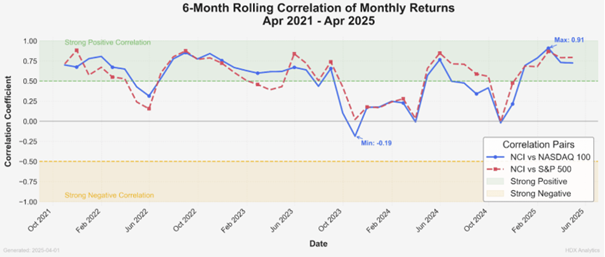
6-Month Rolling Correlation of Monthly Returns between the Nasdaq Crypto Index and Nasdaq-100 (Apr 2021–Apr 2025).
The chart illustrates how this correlation has been increasing since the American elections in November 2024 and spiked to approximately 0.91 in the most recent period—a multi-year high. This visual evidence reinforces the view that crypto assets have been moving closely in tandem with tech stocks, effectively acting as a high-beta version of the Nasdaq-100 during the March risk-off phase.
Following this trend, risk reduction was evident within the crypto asset class. Among the NCI’s constituents, Bitcoin (BTC) posted a decline of -1.93%, withstanding the downturn far better than other constituents such as Ether (ETH, -17.4%) and Litecoin (LTC, -34.6%). BTC’s relatively mild drop in this sell-off aligns with the idea that it increasingly trades like a high-beta proxy for large-cap tech. It still declined, but less severely, whereas smaller-cap crypto assets behaved more like speculative growth stocks and suffered outsized losses. The only exception to the negative results was Cardano (ADA), which surprised with a positive return of 3.88% despite no significant protocol developments during the month.
Thematic indices also faced a challenging environment. As highlighted in previous letters, smaller capitalization assets tend to suffer more during periods of market stress, mirroring how speculative small-cap stocks are hit hardest in equity sell-offs. The biggest negative highlight was the Digital Culture Index, which dropped -17.45%, followed by the Decentralized Finance (DeFi) and Smart Contract Platform (Web3) indices, which fell -16.73% and -12.07%, respectively. The Vinter Hashdex Risk Parity Momentum Index recorded a negative result of -8.26% but outperformed the three other thematic indices, benefiting from its high allocation in BTC and TRX (which gained 4.68%). The heavy weighting in BTC – the more resilient large-cap crypto – helped cushion this index, underscoring the relevance of the momentum factor in a well-diversified strategy during times of market stress.
The market remains on the lookout for the outcome of the fiscal policy discussions, hoping for a reduction in uncertainties and an end to the tariff war. That would likely mark the moment when investors regain their appetite for risk assets, including crypto assets. The U.S. government has also signaled interest in advancing the crypto agenda, a development that could drive the asset class to a new level of adoption. We remain confident in our positive outlook for the rest of the year and the long term.
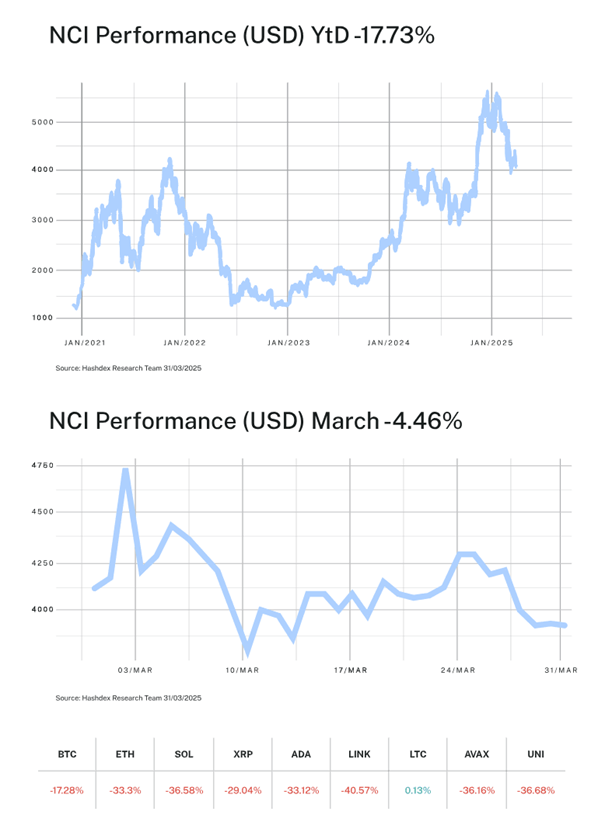
Top Stories
US creates Bitcoin Strategic Reserve and Digital Asset Stockpile
The Bitcoin Reserve will be capitalized with BTC owned by the Department of Treasury, which could further increase via new budget-neutral acquisitions. The stockpile will also include assets owned by the Treasury. This marks a major milestone, with the US government starting to integrate major crypto assets and continues the new administration’s work to lead the global crypto economy.
Stablecoins surpass $230 billion in market value
The total stablecoins market capitalization surpassed $230 billion amid institutional demand for dollar-backed digital assets. This showcases one of the most successful applications for crypto technology enhancing traditional financial payments. It could also pave the way for new use cases that require a strong and reliable global payment system.
FDIC eases banks’ ability to engage in crypto activities
The FDIC has rescinded previous guidelines which prevented financial institutions from engaging with crypto activities without prior sign-off. By removing bureaucratic hurdles, banks may more readily over crypto-related services, potentially leading to broader adoption and integration of digital assets into the financial system.
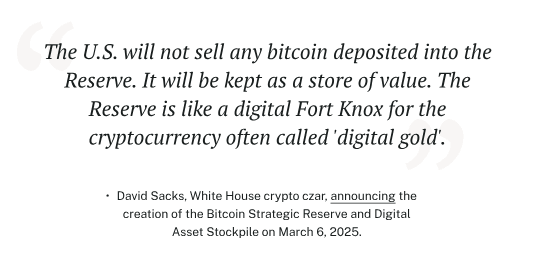

Nyheter
BSE8 ETF ger exponering mot företagsobligationer med förfall under 2028
Publicerad
23 timmar sedanden
5 april, 2025
Invesco BulletShares 2028 EUR Corporate Bond UCITS ETF EUR Acc (BSE8 ETF) med ISIN IE00079EUF59, försöker följa Bloomberg 2028 Maturity EUR Corporate Bond Screened-index. Bloomberg 2028 Maturity EUR Corporate Bond Screened Index följer företagsobligationer denominerade i EUR. Indexet speglar inte ett konstant löptidsintervall (som är fallet med de flesta andra obligationsindex). Istället ingår endast obligationer som förfaller under det angivna året (här: 2028) i indexet. Indexet består av ESG (environmental, social and governance) screenade företagsobligationer. Betyg: Investment Grade. Löptid: december 2028 (Denna ETF kommer att stängas efteråt).
Den börshandlade fondens TER (total cost ratio) uppgår till 0,10 % p.a. Invesco BulletShares 2028 EUR Corporate Bond UCITS ETF EUR Acc är den billigaste och största ETF som följer Bloomberg 2028 Maturity EUR Corporate Bond Screened index. ETFen replikerar det underliggande indexets prestanda genom samplingsteknik (köper ett urval av de mest relevanta indexbeståndsdelarna). Ränteintäkterna (kupongerna) i ETFen ackumuleras och återinvesteras.
Invesco BulletShares 2028 EUR Corporate Bond UCITS ETF EUR Acc är en mycket liten ETF med tillgångar på 6 miljoner euro under förvaltning. Denna ETF lanserades den 18 juni 2024 och har sin hemvist i Irland.
Produktbeskrivning
Invesco BulletShares 2028 EUR Corporate Bond UCITS ETF Acc syftar till att tillhandahålla den totala avkastningen för Bloomberg 2028 Maturity EUR Corporate Bond Screened Index (”Referensindexet”), minus avgifternas inverkan. Fonden har en fast löptid och kommer att upphöra på Förfallodagen.
Referensindexet är utformat för att återspegla resultatet för EUR-denominerade, investeringsklassade, fast ränta, skattepliktiga skuldebrev emitterade av företagsemittenter. För att vara kvalificerade för inkludering måste företagsvärdepapper ha minst 300 miljoner euro i nominellt utestående belopp och en effektiv löptid på eller mellan 1 januari 2028 och 31 december 2028.
Värdepapper är uteslutna om emittenter: 1) är inblandade i kontroversiella vapen, handeldvapen, militära kontrakt, oljesand, termiskt kol eller tobak; 2) inte har en kontroversnivå enligt definitionen av Sustainalytics eller har en Sustainalytics-kontroversnivå högre än 4; 3) anses inte följa principerna i FN:s Global Compact; eller 4) kommer från tillväxtmarknader.
Portföljförvaltarna strävar efter att uppnå fondens mål genom att tillämpa en urvalsstrategi, som inkluderar användning av kvantitativ analys, för att välja en andel av värdepapperen från referensindexet som representerar hela indexets egenskaper, med hjälp av faktorer som index- vägd genomsnittlig varaktighet, industrisektorer, landvikter och kreditkvalitet. När en företagsobligation som innehas av fonden når förfallodag kommer kontanterna som fonden tar emot att användas för att investera i kortfristiga EUR-denominerade skulder.
ETFen förvaltas passivt.
En investering i denna fond är ett förvärv av andelar i en passivt förvaltad indexföljande fond snarare än i de underliggande tillgångarna som ägs av fonden.
”Förfallodag”: den andra onsdagen i december 2026 eller sådant annat datum som bestäms av styrelseledamöterna och meddelas aktieägarna.
Handla BSE8 ETF
Invesco BulletShares 2028 EUR Corporate Bond UCITS ETF EUR Acc (BSE8 ETF) är en europeisk börshandlad fond. Denna fond handlas på Deutsche Boerse Xetra.
Det betyder att det går att handla andelar i denna ETF genom de flesta svenska banker och Internetmäklare, till exempel DEGIRO, Nordnet, Aktieinvest och Avanza.
Börsnoteringar
| Börs | Valuta | Kortnamn |
| XETRA | EUR | BSE8 |
Största innehav
| Namn | CUSIP | ISIN | Kupongränta | Vikt % |
| Volkswagen Leasing GmbH 3.875% 11/10/28 | D9T70CNQ3 | XS2745725155 | 3,875 | 2,19% |
| Swedbank AB 4.25% 11/07/28 | W94240FJ7 | XS2572496623 | 4,250 | 1,63% |
| ABN AMRO Bank NV 4.375% 20/10/28 | N0R37XLP3 | XS2613658710 | 4,375 | 1,62% |
| Carlsberg Breweries AS 4% 05/10/28 | K3662HDY6 | XS2696046460 | 4,000 | 1,60% |
| RCI Banque SA 4.875% 14/06/28 | F7S48DSE5 | FR001400IEQ0 | 4,875 | 1,59% |
| Booking Holdings Inc 3.625% 12/11/28 | — | XS2621007231 | 3,625 | 1,59% |
| Banco Santander SA 3.875% 16/01/28 | E2R99DB46 | XS2575952697 | 3,875 | 1,58% |
| Nordea Bank Abp 4.125% 05/05/28 | X5S8VP8C3 | XS2618906585 | 4,125 | 1,58% |
| E.ON SE 3.5% 12/01/28 | D2T8J8CT1 | XS2574873266 | 3,500 | 1,57% |
| General Motors Financial Co Inc 3.9% 12/01/28 | U37047BA1 | XS2747270630 | 3,900 | 1,57% |
Innehav kan komma att förändras

S5EW ETF är en likaviktad satsning på S&P500

Spotlight on the tariff war

BSE8 ETF ger exponering mot företagsobligationer med förfall under 2028

En vecka för historieböckerna…

VGCF ETF investerar i korta företagsobligationer denominerade i euro

Fonder som ger exponering mot försvarsindustrin

WisdomTree lanserar europeisk försvarsfond.

Warren Buffetts råd om vad man ska göra när börsen kraschar

De bästa börshandlade fonderna för tyska utdelningsaktier

Trumps återkomst får europeiska aktier att rusa
Populära
-

 Nyheter2 veckor sedan
Nyheter2 veckor sedanFonder som ger exponering mot försvarsindustrin
-

 Nyheter4 veckor sedan
Nyheter4 veckor sedanWisdomTree lanserar europeisk försvarsfond.
-

 Nyheter2 veckor sedan
Nyheter2 veckor sedanWarren Buffetts råd om vad man ska göra när börsen kraschar
-

 Nyheter3 veckor sedan
Nyheter3 veckor sedanDe bästa börshandlade fonderna för tyska utdelningsaktier
-

 Nyheter4 veckor sedan
Nyheter4 veckor sedanTrumps återkomst får europeiska aktier att rusa
-

 Nyheter6 dagar sedan
Nyheter6 dagar sedanSvenskarna har en ny favorit-ETF
-

 Nyheter2 veckor sedan
Nyheter2 veckor sedanHANetf lanserar Europa-fokuserad försvars-ETF
-

 Nyheter2 veckor sedan
Nyheter2 veckor sedanEn av de mest nedladdade finansapparna i Sverige


